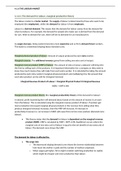4.1.6 THE LABOUR MARKET
4.1.6.1 The demand for labour, marginal productive theory
The labour market is a factor market. The supply of labour is determined by those who want to be
employed (the employees), whilst the demand for labour is from employers.
Labour is a derived demand. This means that the demand for labour comes from the demand for
what it produces. For example, the demand for people who make cars is derived from the demand
for cars. With no demand for cars, there will be no demand for car manufacturers.
As wages increase, hiring workers becomes more expensive and so firms demand fewer workers.
This leads to a downward sloping labour demand curve.
Marginal physical product of labour: Amount of output produced by each extra worker.
Marginal revenue: The additional revenue gained from selling one extra unit of output.
Marginal revenue product (MRP) of labour: The amount of extra revenue a labourer will bring into
the firm by selling each of the products. It is important information for a company as they need to
know how much money they will make from each extra worker. It is calculated by taking the amount
produced by each extra worker (marginal physical product) and multiplying it by the amount that
each extra product can be sold for (marginal revenue)
Marginal Revenue Product of Labour = Marginal Physical Product X Marginal Revenue
MRPL = MPP X MR
Marginal revenue product theory (the marginal productivity theory of the demand for labour)
A rational, profit maximising firm will demand labour based on the amount of money it can earn
from that labour. This is calculated using the marginal revenue product of labour. If workers get
more productive (increased marginal physical product) or the revenue from selling what they
produce (marginal revenue) increases, then the MRP will increase. An increase in
productivity/revenue (i.e. an increase in MRP) will cause firms to hire more workers (demand more
labour).
• This theory states that the demand for labour is dependent on the marginal revenue
product (MRP). MRP is calculated by MRP = MPP x MR. Equilibrium occurs where the
marginal cost of one extra unit of labour is equal to the net benefit of one extra unit of
labour. The demand curve shows the MRP.
The demand for labour is affected by:
• The wage rate
o The downward sloping demand curve shows the inverse relationship between
how much the worker is paid and the number of workers employed.
o When wages get higher, firms might consider switching production to capital,
which might be cheaper and more productive than labour.
, 4.1.6 THE LABOUR MARKET
• Demand for products
o Since the demand for labour is derived from the demand for products, the
higher the demand for the products, the higher the demand for labour.
• Productivity of labour:
o The more productive workers are, the higher the demand for them.
o This can be increased with education and training, and by using technology.
o This is because each worker is producing more goods and services and so firms
will want to hire more workers in order to make more profit.
• Substitutes for labour
o If labour can be replaced for cheaper capital, then the demand for labour will
fall. This will shift the demand curve for labour to the left.
• How profitable the firm is
o The higher the profits of the firm, the more labour they can afford to employ, so
demand may increase.
• The number of firms in the market
o This determines how many buyers of labour there are. If there is only one
employer, for example the NHS, the demand for labour is lower than if there
are many employers, such as in the supermarket industry.
o The lower demand for labour can mean wages are lower, so trade unions try to
encourage higher wages.
Elasticity of demand for labour: How responsive demand for labour is to changes in wage
• If labour demand is inelastic, because there are few or no substitutes, strikes will increase
the wage rate but not affect the employment rate significantly.
• Where there is an inelastic demand for labour, a lower supply will lead to a higher increase
in the wage rate (P1 -> P3), than where there is a more elastic demand (P1 -> P2)
What affects elasticity of demand:





